
Library of Congress
‘The Battle of Bad Axe’; illustration by Henry Lewis, 1857. In Surviving Genocide, Jeffrey Ostler writes, ‘Toward the end of the 1832 Black Hawk War, a cannon aboard the US steamship Warrior fired on Sauks and Mesquakies trying to escape US troops by crossing the Mississippi River. What the image shows is clearly a massacre, but in an especially striking example of colonial evasion, the caption refers to the event as a battle.’
At the close of the introduction to Surviving Genocide, his intense and well-researched overview of American Indian land losses, population declines, and personal miseries from the years leading to the republic’s birth through the wholesale tribal removals of Andrew Jackson’s presidency, the University of Oregon historian Jeffrey Ostler doubts whether the federal government will ever “establish a Truth and Reconciliation Commission to honestly assess the United States’ impact on Native nations and propose meaningful remedies, including land return, for deep historical injustices.” Yet the most productive way to plow through his catalog of the unrelenting horrors and tragedies visited upon American Indians from the Atlantic coast to the Mississippi River is to imagine it as an early draft of the first volume of just such a report, a mammoth affidavit that, once completed, will cry out for that overdue reckoning.
Ostler makes an ambitious case that there was a more or less continuous campaign of brutal conquest, diplomatic duplicity, and near genocide, but he does not ground it on a few cherry-picked highlights in the long history of relations between Euro-Americans and Native Americans, as the freelance author Ronald Wright did with his Iroquois and Cherokee examples in Stolen Continents: The “New World” Through Indian Eyes Since 1492 (1992). Instead his magisterial perspective in this volume takes in the vast trans-Appalachian region with all its tribes and subtribes; the continent’s trans-Mississippi West will be similarly covered in volume 2.
Ostler’s swift-paced yet meticulous coverage of the wars and diasporas, great and small, and attendant fluctuations in native populations has been assembled as if he intends it to be his academic generation’s manifesto, one that argues, as expressed in the upbraiding title of a recent anthology, Why You Can’t Teach United States History Without American Indians (2015). That collection of essays offered native-centered investigations into the history of Indian slavery, native literacy, maps in historical textbooks, native women during the colonial period, civil rights activism, the significance of Indians to narratives of modernity, and post–World War II urban migrations. No longer, insist its contributors, can American history books minimize, marginalize, or rest upon entertaining sidebars wherever American Indians—in all their tribal, personal, temporal, and circumstantial diversity—were implicated, which is the case in even such recent works as Jill Lepore’s These Truths: A History of the United States (2018) and David McCullough’s The Pioneers: The Heroic Story of the Settlers Who Brought the American Ideal West (2019).
Ostler’s contribution to Why You Can’t Teach United States History Without American Indians, which addressed critical omissions in writings about the Plains Indian wars, gave little hint that he was piecing together this grand synthesis. But Juliana Barr’s opening chapter to that collection laid out the geopolitical premise of Surviving Genocide:
At the time of European invasion, there was no part of North America that was not claimed and ruled by sovereign Indian regimes. The Europeans whose descendants would create the United States did not come to an unsettled wilderness; they grafted their colonies and settlements onto long-existent Indian homelands that constituted the entire continent.
To back up this foundational claim, the first of Ostler’s many useful maps depicts a jigsaw puzzle of dozens of separate tribal territories nestling against one another in 1760, from the Atlantic seaboard to the eastern parts of the 1803 Louisiana Purchase, with hardly any space between them. By the end of his account, most of these native nations have been decimated and displaced, year by painful year, as a result of warfare, famine, disease, diplomatic pressure, coercive land turnovers, and sheer exhaustion. This does not mean that Indians did not put up a fight; indeed, Pontiac’s multitribal rebellion of the 1760s is one of the more riveting episodes of Ostler’s chronicle, even if it proved incapable of stemming the settler tide.
Ostler’s historical-ideological premise is heavily influenced by two relatively new subfields in American Indian history. One is settler colonialism studies, an approach that was first elaborated about twenty years ago by the Australian historian Patrick Wolfe. The second is genocide studies, which historians such as Benjamin Madley, who applied the 1948 United Nations genocide criteria to the “California Indian Catastrophe” of 1846–1873, have found increasingly relevant to characterizing the fate of their native subjects.* Today the term “settler colonialism” has become the shorthand explanation across American campuses, especially within ethnic and American studies programs, whenever and wherever indigenous residents—Japanese Ainus, First Peoples of Australia, Canadian First Nations, or Native Americans—were reduced by famine and disease, murdered in encounters famous and obscure, or forcibly or faux-legally evicted from traditional homelands.
Advertisement
As if impatient with wordy exegeses, Ostler defers here to the historian Lorenzo Veracini’s definition of the term: in classic seventeenth-century colonialism, explains Veracini in his Settler Colonialism: A Theoretical Overview (2010), “the colonizer says to the colonized, ‘You, work for me.’ By contrast, in settler colonialism [of the Australian and American kind], the colonizer says, ‘You go away.’” Rather than being conscripted by colonizers to exploit local resources—precious metals, fur-bearing animals, timber-rich forests, grazing or agricultural acreage—the resident natives are removed to make room for another workforce, whether imported slaves or incoming settlers. The UCLA historian Kelly Lytle Hernández explains this process in City of Inmates: Conquest, Rebellion, and the Rise of Human Caging in Los Angeles, 1771–1965 (2017):
Settlers invade in order to stay and reproduce while working in order to remove, dominate and, ultimately, replace the Indigenous populations. In the words of historian Patrick Wolfe, settler societies are premised on the “elimination of the native.”
Ostler’s approach is not the first time that the discipline of American history, specifically the history of the American West, has been dramatically updated. By the 1980s the genial acceptance of Frederick Jackson Turner’s so-called Frontier Thesis of 1893 had withered. Contrary to its title, Turner’s argument was less a formal thesis than a triumphalist diagnosis of the distinctive American character, claiming that it had been fundamentally marked by early Anglo-European confrontations with the rough-and-ready and westward-shifting frontier, which bequeathed to the country, in the historian Patricia Nelson Limerick’s words, “an ever-expanding zone of freedom, opportunity, and democracy.” But as deeper historical self-awareness during the 1960s and 1970s revealed, Turner’s hyperpatriotic analysis conveniently ignored—as Limerick went on to stress in Something in the Soil: Legacies and Reckonings in the New West (2000)—glaring examples of illegal appropriation of natural resources, impositions of colonial dominance, and, particularly, “processes of collaboration, intermarriage, and syncretism” that “reshaped the lives of native people”—referring to all those American Indian nations apparently unworthy of mention in Turner’s formulation.
To correct the record and fill in these ignored stories, Limerick and the so-called New Western Historians, whose counterperspectives she often spoke for, replaced the geographical definition of “frontier” with the more critical concept of “conquest.” Younger scholars and their students began unearthing the experiences of Indians, Hispanics, and women, and factored the global economy and even the West’s climatic challenges into accounts of rapacious capitalism, environmental desecration, global slavery, political skullduggery, intervals of relative amity, and Indian resistance; they also made realistic assessments of the limits of progress in a region as ecologically challenging and ethnically complex as the American West.
Some of the current Young Turks like Ostler, however, who are building on Wolfe’s work, have leveled accusations of the ultimate crime: the genocide of American Indians, whether intended or inadvertent. In the obvious absence of evidence for any overt Final Solution conspiracy, Ostler attempts to substantiate a narrative of relatively consistent “genocidal” intent, whether hushed or occasionally explicit, over time. His attempt is but the latest and most comprehensive of those enormous syntheses on Indian–white relations in North America that appear every quarter-century or so as American scholars feel the still-unsatisfied need to make sense of the devastating encounters that by 1900 left a little over 237,000 Indians alive in the United States out of the estimated 12–15 million from over three hundred native nations that existed in North America in 1492.
Before fast-forwarding into his central narrative, Ostler dispenses with simplistic explanations for Indian depopulation, especially disease. “Recent scholarship,” he writes, “has shown that virgin soil epidemics did not occur everywhere and that Native populations did not inevitably crash as a result of contact.” While smallpox, measles, tuberculosis, and other illnesses certainly caused huge loss of life,
it was often less because Native bodies lacked immunity than because European colonialism disrupted Native communities and damaged their resources, making them more vulnerable to pathogens.
As a Canadian counterpart to Ostler’s work, James Daschuk’s Clearing the Plains: Disease, Politics of Starvation, and the Loss of Indigenous Life (2019), makes similarly clear, it was most often the destruction of primary food resources that left Indians so susceptible to infections. To famine and malnutrition were then added enslavement, incessant forced removals, and constant social stress, which desperately weakened bodies and enabled pathogens to thrive.
Ostler introduces his narrative strategy with a spotlight on the Little Tennessee River in mid-1776. Representatives from half a dozen resistant tribes gathered in the old Cherokee capital of Chota to discuss thwarting the colonial aggressors. To one Shawnee tribal orator the threat from these “Virginians,” as they were collectively known, was ominous. The thirteen colonies had made it “plain, there was an intention to extirpate them.” Ostler unearthed this quote, we learn in footnotes, from the colonial records of North Carolina; otherwise it comes with no name, no other context.
Advertisement
With that warning from the eve of American independence, Ostler harkens back to the early 1700s. Tribes were already abandoning homelands; over the previous century the Delaware had been reduced from an estimated 10,000 to 3,000. “Their experience,” writes Ostler, “led them to conclude that the English colonists ‘wanted to get rid of them and deliberately infected them by selling them matchcoats that had been exposed to smallpox germs,’” an accusation that he dug out of The Jesuit Relations, the chronicle of the Jesuit mission in France’s North American colonies. In 1754, at the start of the Seven Years’ War, Delaware tribal leaders were explicitly warning that the “French and English intend to kill all the Indians.” So begins Ostler’s litany of genocide-fearing statements from Indians that regularly appear, like courtroom exhibits, throughout his narrative.
The first quotes from the Anglo-European side come eight years later. A British superintendent of Indian affairs reported that the western Indians were fearful “that we should hem them in and in the end extirpate them.” The following year a British colonel suggested trying “Every other method that can serve to Extirpate this Execrable Race.” That is also when a Moravian missionary serving a colony of Christian Indians reported that frontiersmen had adopted the “doctrine…that the Indians were the Canaanites, who by God’s commandment were to be destroyed.”
Hardly five years go by in Ostler’s fast-moving précis of every significant Indian–white flashpoint—whether violent or diplomatic—without a quote from such back-and-forth insights into motivations and suspicions: Indians expressing rising fears about white Americans’ true motives; Americans hiding less and less their intentions behind the diplomatic legalese through which they threaten, bribe, and persuade Indians to get out of their way. Ostler interrupts this ongoing dialogue of sorts with sketches of bloodshed and suffering that become a numbing vindication of the poet Jim Harrison’s observation: “the true sound of history, this metal striking bone.”
The highest officials in the land echoed and supported settlers’ desires for wholesale Indian removal or worse. While the famous Ottawa rebel leader Pontiac hoped that the Proclamation of 1763, which forbade settlement west of the Appalachians, would resolve the need for a permanent boundary between and Indian and white domains, George Washington privately regarded it as “a temporary expedient to quiet the Minds of the Indians.” After the mobilized tribes of the Ohio and Illinois river valleys continued to resist white aggression, Thomas Jefferson urged “their extermination, or their removal beyond the lakes or Illinois river,” a view he repeated over the next thirty years. Watching some drunken Indian refugees in western Pennsylvania, Benjamin Franklin mused in his autobiography, “And, indeed, if it be the design of Providence to extirpate these savages in order to make room for cultivators of the earth, it seems not improbable that rum may be the appointed means.”
By the book’s second part, all pretense of nation-to-nation negotiations is gone. During the 1830s the elimination of the so-called Five Civilized Tribes from the southeastern states reached and remained atop the national agenda. The tribal removal policies, aggressively promoted by President Jackson, a diehard Indian antagonist, represented the apotheosis of genocidal intent. Even as Ostler’s citations of the ups and downs of Indian demographic statistics show that, in reality, natives seized every moment of surcease from white pressures to “adapt to changing conditions and rebuild their populations,” US policymakers argued that they “were vanishing and needed to be moved to ‘save’ them from total extinction.”
Whether because of local pressure, increased instability due to famine or warfare, or treaties whose fine print demanded land cessation, tribes became accustomed to incessant pressure to pack up and go. The Osage averaged a hundred miles westward every ten years after 1750; the Delaware were “broken up and removed six times,” their Chief Journeycake recalled. Dispossession and forced migration became the first pan-Indian experience. “I think you had better put the Indians on wheels,” a Sioux named Red Dog later told white treaty commissioners. “Then you can run them about whenever you wish.”
Ostler’s compendium of evidence reveals an unspoken truth that will extend from sea to shining sea: the United States was built upon many localized or regional determinations that amounted, in his view, to one insistent and continuous imperative. For the new republic and its pioneering settlers to thrive, the aboriginal citizenries had to be displaced, removed, extirpated, eliminated, exterminated. If Indians were characterized as less than human—as pests, parasites, or marauding animals—their eradication could be turned into a practical, mandatory, and virtuous cleansing. What is remarkable is how long it has taken historians like Ostler to perceive and document this insidious pattern.
With the stakes for credibility so high, every scrap of historical information—and Ostler’s paraphrases based on them—should contribute to making such grave charges as incontrovertible as possible. Relying on quotes of private intention and confidential predictions may seem insufficient, but in the accumulation they establish the permissive climate that easily led to Indian community harassment, native land takeovers, forced tribal removals, and outright killings. And Ostler is not the first historian to find such sources convincing. A half-century ago, in his introduction to a reissue of the Apache freedom fighter Geronimo’s autobiography, the historian Frederick Turner (not related to Frederick Jackson Turner) cited William Tecumseh Sherman’s declaration that his troops must confront the enemy Sioux “even to their extermination, men, women, and children” and General Philip Sheridan’s statement that “the only good Indians I know are dead” in support of his conclusion:
such statements make clearer than reams of official documents could what the real operating procedure was to be in the Plains campaigns. It was to be extermination, pure and simple, for the cause was holy, the provocations many, and the army almighty.
Ostler’s litany of ominous quotes, bloody outrages, and abrupt demographic declines, his close attention to the tragic fates of small tribes and subtribes, and his piling up of misery upon misery, empty stomach upon empty stomach, and social stress beyond imagining, vibrate with moral outrage. Together they forcefully make his case: during the formative years of our republic and beyond, there was a mounting, merciless, uncoordinated but aggressively consistent crusade to eliminate the native residents of the United States from their homelands by any means necessary—and those homelands were everywhere.
For many of us, I suspect, who have researched and taught Indian–white relations most of our lives, Surviving Genocide sets a bar from which subsequent scholarship and teaching cannot retreat. One awaits volume 2 with a mixture of dread for the approaching bloodshed and human suffering that Ostler will undoubtedly expose and humble amazement at the spiritual fortitude and social stamina that have sustained Native Americans through all this.
-
*
See my review in these pages of his An American Genocide: The United States and the California Indian Catastrophe, 1846–1873 (Yale University Press, 2016), November 24, 2016. ↩




